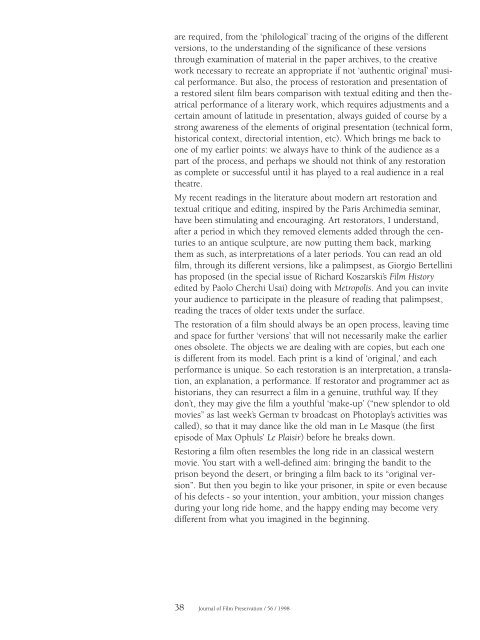Journal of Film Preservation N° 56 - FIAF
Journal of Film Preservation N° 56 - FIAF
Journal of Film Preservation N° 56 - FIAF
Create successful ePaper yourself
Turn your PDF publications into a flip-book with our unique Google optimized e-Paper software.
are required, from the ‘philological’ tracing <strong>of</strong> the origins <strong>of</strong> the different<br />
versions, to the understanding <strong>of</strong> the significance <strong>of</strong> these versions<br />
through examination <strong>of</strong> material in the paper archives, to the creative<br />
work necessary to recreate an appropriate if not ‘authentic original’ musical<br />
performance. But also, the process <strong>of</strong> restoration and presentation <strong>of</strong><br />
a restored silent film bears comparison with textual editing and then theatrical<br />
performance <strong>of</strong> a literary work, which requires adjustments and a<br />
certain amount <strong>of</strong> latitude in presentation, always guided <strong>of</strong> course by a<br />
strong awareness <strong>of</strong> the elements <strong>of</strong> original presentation (technical form,<br />
historical context, directorial intention, etc). Which brings me back to<br />
one <strong>of</strong> my earlier points: we always have to think <strong>of</strong> the audience as a<br />
part <strong>of</strong> the process, and perhaps we should not think <strong>of</strong> any restoration<br />
as complete or successful until it has played to a real audience in a real<br />
theatre.<br />
My recent readings in the literature about modern art restoration and<br />
textual critique and editing, inspired by the Paris Archimedia seminar,<br />
have been stimulating and encouraging. Art restorators, I understand,<br />
after a period in which they removed elements added through the centuries<br />
to an antique sculpture, are now putting them back, marking<br />
them as such, as interpretations <strong>of</strong> a later periods. You can read an old<br />
film, through its different versions, like a palimpsest, as Giorgio Bertellini<br />
has proposed (in the special issue <strong>of</strong> Richard Koszarski’s <strong>Film</strong> History<br />
edited by Paolo Cherchi Usai) doing with Metropolis. And you can invite<br />
your audience to participate in the pleasure <strong>of</strong> reading that palimpsest,<br />
reading the traces <strong>of</strong> older texts under the surface.<br />
The restoration <strong>of</strong> a film should always be an open process, leaving time<br />
and space for further ‘versions’ that will not necessarily make the earlier<br />
ones obsolete. The objects we are dealing with are copies, but each one<br />
is different from its model. Each print is a kind <strong>of</strong> ‘original,’ and each<br />
performance is unique. So each restoration is an interpretation, a translation,<br />
an explanation, a performance. If restorator and programmer act as<br />
historians, they can resurrect a film in a genuine, truthful way. If they<br />
don’t, they may give the film a youthful ‘make-up’ (“new splendor to old<br />
movies” as last week’s German tv broadcast on Photoplay’s activities was<br />
called), so that it may dance like the old man in Le Masque (the first<br />
episode <strong>of</strong> Max Ophuls’ Le Plaisir) before he breaks down.<br />
Restoring a film <strong>of</strong>ten resembles the long ride in an classical western<br />
movie. You start with a well-defined aim: bringing the bandit to the<br />
prison beyond the desert, or bringing a film back to its “original version”.<br />
But then you begin to like your prisoner, in spite or even because<br />
<strong>of</strong> his defects - so your intention, your ambition, your mission changes<br />
during your long ride home, and the happy ending may become very<br />
different from what you imagined in the beginning.<br />
38 <strong>Journal</strong> <strong>of</strong> <strong>Film</strong> <strong>Preservation</strong> / <strong>56</strong> / 1998

















